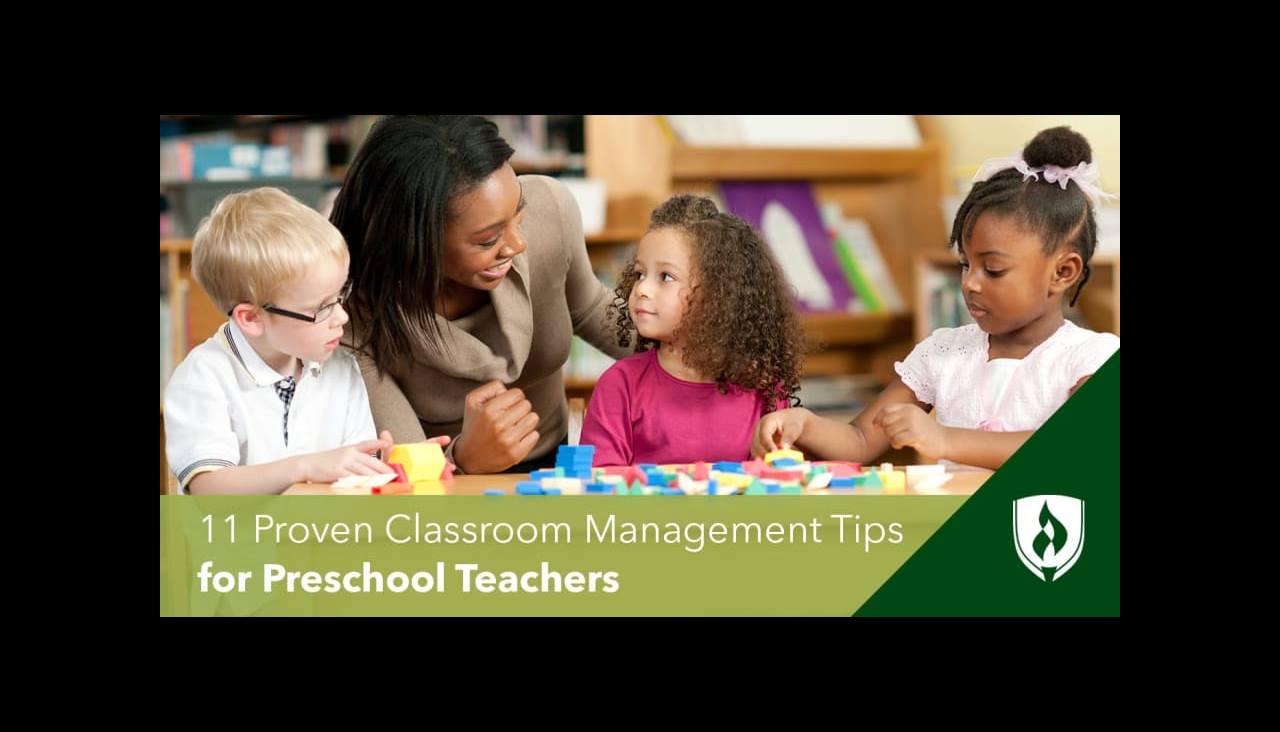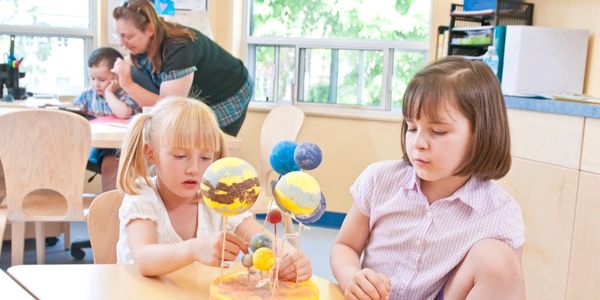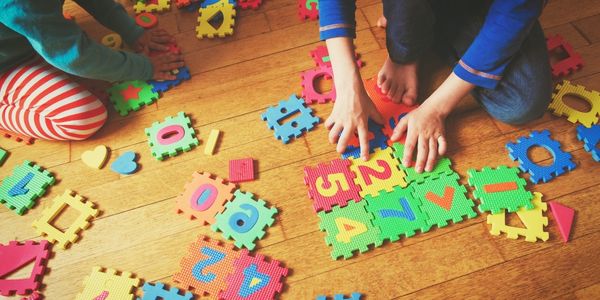
Picture a busy classroom scene with excited children carrying on. The teacher, ready to regroup and move on to the next activity stands up and calls out, “1-2-3 little red school house!” and the children slowly but surely pick up on the cue, quiet down and wait for the teacher to speak.
Maybe you can remember your preschool teacher using this phrase or a similar approach to quiet down the classroom and get everyone’s attention. At the time, you probably didn’t realize you were responding to a tried-and-true classroom management technique—it just seemed like a game you played with the teacher. But now that you’re exploring an early childhood education (ECE) career, classroom management takes on a whole new importance.
It’s not always easy keeping a day on track when working with kids who are just figuring out the basics of how to socialize and adjust to a classroom setting. So what can ECE teachers do to help keep things running smoothly? We asked preschool teachers and ECE experts for their best classroom management tips and techniques.
11 Classroom management tips worth trying
Looking to keep an orderly preschool classroom? Consider trying the following:
1. Organize your room strategically
A preschool classroom can be quite chaotic, so the way you organize is important in that it can help ensure that effective learning is happening wherever children are stationed. There are certain tips and tricks that you can only learn from experience, according to Barbara Harvey, ECE professional and parenting educator.
She’s learned to separate noisy areas of the classroom from the quiet ones. For example, the blocks and other activities should be on the opposite side of the room from the reading center.
“There should be clearly demarcated areas in the room—like reading, timeout, play, food—and rules surrounding those areas,” says Adam Cole, co-director at Grant Park Academy. If the ‘boundaries’ of each space are clear, it facilitates the relationships in the room, Cole says. “Difficult situations occur less often and can be resolved more quickly.”
2. Emanate comfort and reassurance
There is a physical environment in each classroom, but perhaps on an even more important note—there’s the atmosphere you create by your tone and demeanor. Children are often very perceptive of attitude towards them. “Teachers should be warm and caring toward children who are acting upset,” says Stephanie Leclair of Tiny Hoppers.
Leclair says that trying to comfort the child and reassure them that they are not alone is worth trying when a student is upset. “Every child is different, but with some children, all they really need is a warm hug to calm down.” If you make yourself open to your students, they might be able to communicate why they are upset and help you solve the issue.
3. Give them tools to express their feelings
Little ones don’t always know how to manage their emotions or communicate their feelings. When a child gets upset, answering a question like ‘what’s wrong?’ can be difficult. But Cole says children don’t necessarily need to communicate why they are upset if they can express their emotions creatively.
Cole encourages teachers to offer children options of song, art, movement in a quiet space set apart from the group. “Then they should be allowed to manage their feelings either by waiting in the ‘safe’ place until they are able to participate, or by having their feelings and being with the group anyway. Teachers can offer gentle assistance if students do not know how to manage their feelings, with the goal of continuing the flow of the day.”
4. Make a plan for transitions
There will be several times throughout the day when children are transitioning from one activity or area of the room to another. It’s important to have a plan for these transitions.
Harvey suggests using a countdown as part of your plan so children are ready to move on when the time comes. Announcing that you’re going to countdown from 10 to one before moving on to the next activity will help children feel prepared for the transition.
Drift time can be hard for children, so having a solid plan with no gaps is definitely a must according to Cole. “It's not that teachers can't improvise or be diverted, only that there should never be a time when the teacher doesn't have an option for something to do.”
5. Follow the kids from time to time
Speaking of being diverted, Cole says there are times to put the plan aside when you can tell it would be beneficial for your students.
“One time I found that all my students had abandoned my circle and had gotten interested in playing under the table. So I got under the table with them. That's where we continued class.”
Whether it’s teaching under a table, moving free time around or focusing on something the kids are particularly interested in that day, being flexible and matching their natural interests can make the day more interesting and exciting for them.
6. Use child-friendly labels
Keeping your room organized shouldn’t entirely fall on your shoulders. Empower your students to pick up after themselves and take responsibility for their own messes.
Harvey uses labeled plastic bins to organize classroom supplies and toys. She labels the bins with pictures of each object and labels the shelf where the bin is stored with the same picture. She says this not only helps children put things away properly and teaches responsibility, but also helps hone their matching skills.
7. Refer to the routine
Consistency is important for everyone, but especially for children. If your preschoolers know their routine, they begin to have an innate sense of accountability to follow it. Even something as simple as writing the day’s schedule on the board or making pictures to represent activities can help children anticipate the routine and feel more comfortable.
8. Create integrated learning environments
“A developmentally appropriate environment for a toddler or preschooler takes a holistic approach,” says Elizabeth Malson, president of the Amslee Institute. Malson says dedicating spaces to auditory, visual and social/emotional development areas will help toddlers make connections between their experiences and the world around them.
“Focus on creating a space that is conducive to a child’s visual, auditory and emotional development,” Malson says. When children grow, they need support in all of these areas. Appealing to the toddler’s sense of curiosity is a great approach, Malson says.
Integrated learning environments have individual learning centers or stations which allow children to safely explore and play, Malson explains. “At this age, it’s important to keep learning centers simple so children are not overwhelmed.” For example, toddlers can enjoy a literacy corner with a comfy chair and a few books.
“Sand and water tables are popular as well as a block or building center,” Malson says. “Daily exercise and outdoor play is important and visiting a park is a type of learning center as well. Toddlers also enjoy dress up and craft stations.”
9. Balance ‘active’ & ‘passive’ activities
Certain activities will get your students’ pumped up and giddy with excitement, and others will help them mellow and calm down. Harvey recommends finding a balance and switching between the two. Trying to keep kids silent when they are bubbling over with energy will be far less productive than giving them an activity to blow off some steam.
The manner in which you organize your activities can make all of the difference in keeping your kids engaged and avoiding meltdowns.
10. Tackle ongoing issues with creativity
Most little ones will have grumpy days. But you might start to notice patterns in your classroom that represent an ongoing struggle for specific students. That’s when it’s time to take a step back and analyze the situation. Leclair recalls a time when she taught a student who particularly did not enjoy sensory activities.
“It made following our lesson plans challenging as we generally had several messy activities to do a day. What could we do to make things more enjoyable for this child? Could we come up with some sort of solution for him?”
Leclair says one of her fellow teachers suggested gloves. “Sure enough, the next day we brought out a big bin of goop. We asked him if he'd like to try wearing gloves before touching the goop. He thought it was a pretty cool idea, put them on and dug his hands right in. Presto! Problem solved.”
11. Enjoy your job!
Kids are naturally intuitive and tend to follow the lead of those they’re around. If they see you enjoying the teaching process, think of how much more likely they are to enjoy the learning process.
Teaching preschool can be full of laughter and little delights, and when children see you having fun and making the day bright, it will help them come along for the ride. While not every day is going to be sunshine and rainbows for you, putting on a good front and approaching the day with enthusiasm can lead to a positive feedback loop that might just make your day a little brighter. Check out funny things kids say in the classroom to make your day brighter.
Discover your own classroom management techniques
As you can see, there are so many good ideas for how to approach preschool classroom management. And when you are on the job, working with kids day after day, you might feel your intuition kicking in, helping you navigate. And of course, teacher networks are rich with helpful advice and creative solutions.
“When you hit a situation you can't handle, ask questions of experienced teachers, and take whatever works for you,” Cole says. “Then forgive yourself for what didn't go well and come back the next day. The kids don't expect you to be perfect, just to be fully present.”
If these tips for classroom management are giving you a few ideas on what you would do as a preschool teacher, check out “7 Teaching Strategies to Consider for Your ECE Classroom” and keep the inspiration flowing! Additionally, check out the importance of recess.
Stay up to date with the latest preschool teacher blogs.
The Early Childhood Education programs at Rasmussen University are not accredited by the NAEYC Commission on Early Childhood Associate Degree Accreditation. Rasmussen University is not a partner of NAEYC and our programs are not sponsored or endorsed by NAEYC.
Graduates of Early Childhood Education programs at Rasmussen University are not eligible for licensure as a teacher in an elementary or secondary school. A Bachelor’s degree and a state teaching license are typically required to work as a teacher in a public school and some private school settings. States, municipalities, districts or individual schools may have more stringent licensing requirements. Students must determine the licensure requirements in the state and school in which they intend to work. Childcare facilities and the states in which they are located establish qualifications for staff who work with children, and often implement guidelines regarding age, education, experience and professional development. Students must determine the licensure requirements for the state and facilities in which they work.
This program has not been approved by any state professional licensing body, and this program is not intended to lead to any state-issued professional license. For further information on professional licensing requirements, please contact the appropriate board or agency in your state of residence.
Related Articles:




